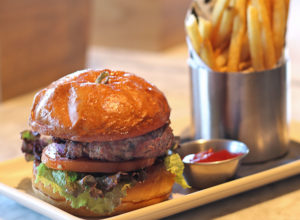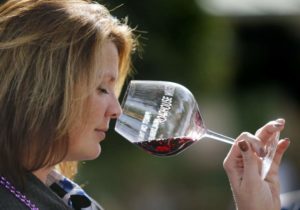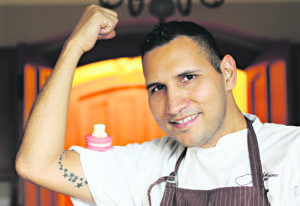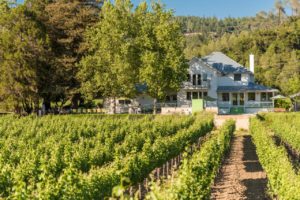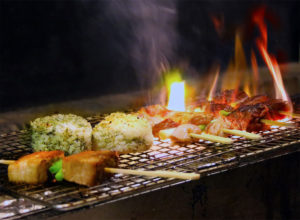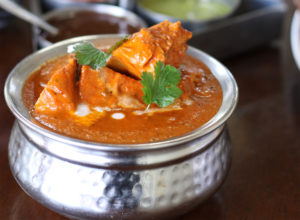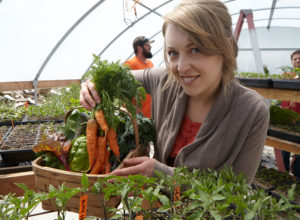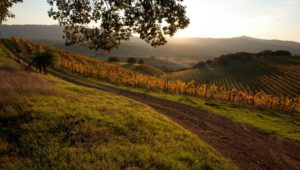Julie Golden’s dance card was full long before she opened The Golden Pig restaurant in Hopland earlier this summer.
There was the massive fire that wiped out acres of grazing land for the animals Mendocino Meats’ Adam Gaske raises on her 2000-acre ranch near Ukiah. Then there are she and her husband Joe’s winery and vineyards; four school-age children and a menagerie of animals. And her wine shop.
But it was her ongoing frustration about how restaurants source their food that made her a newly-minted restaurateur as well.
After years of selling her grass-fed beef, pork, and chicken to high-end chefs, then watching them cancel orders when she claims her prices were undercut by larger food suppliers, she figured she’d put her money where her meat was.
In late June, she opened The Golden Pig as an outlet for her beef, pork, chicken, eggs and produce—with that of nearby farmers—and as a sort of experiment in bringing true farm-to-table food to more people.
“I didn’t do this to just to be a restaurateur,” she said. “I did it because I love farmers and I want people to be able to thank me for bringing them great food.”

The Philosophy
Calling her restaurant farm-driven, rather than farm-to-table, the mission behind The Golden Pig is to grow honest food in healthy soil with clean water, lots of sunshine and minimal intervention, “to keep you healthy”, according to Golden. “We’re investing in the land and the farmer, creating a culture that strengthens goodwill among local businesses and delivers fine food to each of our customers. It feels good to cook with honest ingredients. And it feels even better knowing we’re nurturing the land for future generations,” says the menu.
Golden hasn’t hired a chef, but trains her cooks to execute simple dishes she’s helped to create, frequently based on what’s available rather than what can be delivered by a food service company.
“Farmers need somewhere for their food to go,” she said, adding that the claim of farm-to-table sometimes far exceeds the reality of what restaurants are actually serving.
As a producer, she said that frequently top San Francisco chefs would feature her locally-produced products for a while until food service suppliers were able to offer substantially lower prices than those being offered by her farm and other small producers.
Since restaurants frequently have slim margins on food costs, Golden said it’s understandable, but frustrating to lose those accounts.

“This wasn’t something I was just doing in my spare time,” she said. “I’m making good food, using the entire animal, and being sustainable. I thought it would be easy to make people understand. But until I opened a restaurant I didn’t understand,” she said.
“Now I understand why restaurants can’t easily work with small farmers. It’s complicated and there are market forces that incentivize restaurants not to. Yes, there are chef-driven restaurants like Thomas Keller’s that are truly farm-to-table but that’s just not affordable to the average person,” she said. By using her own products, and those of her friends, she hopes to both keep costs low and showcase the food of the region.
Location, Location
Hopland has long suffered from drive-by syndrome. Fifteen miles north of Cloverdale, the thousand-resident hamlet is bisected by Hwy 101 — only two slow-moving lanes here — with cars and trucks mostly passing through. But the Piazza de Campovida inn and tavern, along with the Emerald Pharms cannabis dispensary at the Solar Living Center, and other new wineries and other restaurants like Golden’s are suddenly catching the attention of travelers.

Beautifully remodeled with recycled materials and clean lines, The Golden Pig is actually housed in one of the oldest buildings in Hopland — a 19th-century saloon called the Cottonwood. The centerpiece of the dining room is the original bar from the Yuengling Brewery in Pottsville, PA, the nation’s oldest brewery. Her mother, says Golden, bought the piece at an auction, and used it for years in her Ukiah dress shop, Esther’s, with it later sitting in Golden’s barn, and now restored to its original glory. The full bar serves signature cocktails made with fresh local berries, muddled herbs and infused liquors, along with local beers on tap, a curated wine list with mostly nearby wineries (including their own Golden Winery), house made shrubs using seasonal produce from Heart Arrow Ranch.
More than just libations, they’re tasty symbols of Golden’s crusade toward of delicious sustainability.
“Opening this restaurant is giving me insight into the system, and I can affect change more easily. I want to have this conversation about food, I want farmers to continue farming. Otherwise, what’s my legacy?”
Best Bets:

– Kale Caesar, $10: Baby kale mixed with shaved Parmesan, anchovy and garlic croutons. A massive portion, gently dressed with tender kale that’s sweeter and less tooth-gnashingly hard than more mature leaves.
– The Golden Pig, $16: Pork-on-pork action with Mendocino Meats pork hot dog and sweet pulled pork snuggled into a pretzel bun. Whole grain mustard and kraut give a sharp contrast to all the oink. If you’re wiener fan, this is your dish. Served with fries.
– Pork Schnitzel Sandwich, $16: Golden’s favorite, based on her time as a consultant in Germany, it’s a sweet piece of breaded Dijon pork loin, Swiss, and onions on a soft Franco-American roll.
– Grass fed Burger, $12: Currently, Golden is using nearby Macgruder beef, served with all the fixings and garlic aioli. Grass fed beef that isn’t grain-finished can be a bit drier than corn-fed, so ask for your burger a little rarer than you might otherwise.

– Egg Custard, $3: Served in a jar, this homemade custard is creamy and rich without veering into the cloying sweetness of creme brulee. Addictive. Grab a few from the refrigerator to take home.
– Orange Rosemary Shrub, $4: Fruit vinegar is mixed with soda water for a refreshing, thirst-quenching drink. The combination of savory herbs and sweet orange is a winner.

– Elderflower Sparkler, $8: Vodka, Prosecco, muddled basil, grapefruit and elderflower liqueur. Pink, pretty and dangerously good–consume with caution.
If you go:
– Larger dinner portions are served after 6 p.m., including grass fed steak ($26), Heart Arrow Ranch chicken ($22) and smoked pork chops ($22), all served with mashed potatoes, carrots, and mixed greens.
– The building is broken up into three sections, with a small refrigerated section and walk-up counter for ordering, a tiny outdoor patio and larger dining room and bar. Take-out items are available at the counter.
– All dishes are available gluten-friendly, tapping nearby Pamela’s Bakery for their wheat-free bread. Vegan and vegetarian dishes including white bean chili and a garden burger are available. The restaurant is also family-friendly, with a creative children’s menu.
Needs Improvement: The restaurant is just getting started, so some inconsistencies, like dry vegan chili and slightly overcooked cornbread, will hopefully be sorted quickly. Ingredients do change up, and sometimes certain dishes aren’t available (we couldn’t get the delicious-sounding ceviche on our visit), so be a little flexible–this is farm-centric dining. The menu will expand in the fall with even more options, and we’ll look forward to that.
The Take Away: Supporting small local farmers always leaves a great taste in our mouth, and The Golden Pig is no exception.
The Golden Pig, 13380 S. Hwy 101, Hopland. Sun-Thurs 11am-9pm, Fri-Sat 11am-11pm, 707-670-6055, thegoldenpig.com


